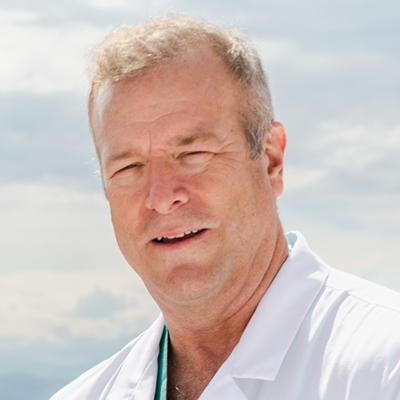The Next Generation of Digitally Enabled Healthcare Innovations
September 2021
At the University of Colorado Anschutz Medical Campus, putting our patients first is in our DNA. One of the many ways we seek to provide exceptional healthcare is through cross-campus collaboration and partnerships with experts. CU Innovations exists to do just that. By bringing together industry partners, entrepreneurs and investors, CU Innovations is helping our researchers create biomedical technology that improves patient care.
“We see ourselves as the main gateway to a large research and clinical infrastructure,” explained Kimberly Muller, executive director of CU Innovations. “The whole concept of what we do is to create the next generation of healthcare products, whether it’s drugs, devices or redesigning care delivery. We bring industry partners and pair them with clinicians to figure out how we can create those next-generation products that can ultimately reach patient care.”
Thanks to hospital partners at Children’s Hospital Colorado and the UCHealth system, CU Innovations has established a living clinical laboratory for testing and validating the best healthcare technologies. One recent partnership with Clay Smith, MD, director of the Blood Disorders and Cell Therapies Center at University of Colorado Hospital and associate chief, Division of Hematology, CU School of Medicine, revolved around developing new therapies for adults with leukemia. His work specifically focuses on acute myeloid leukemia (AML), a type of cancer that affects the bone marrow and blood and is the second most common leukemia type found in adults.

Smith was already working with another researcher on campus, Craig Jordan, PhD, chief, Division of Hematology, on new technologies and treatments for AML. Together, they came up with an idea to use cutting-edge technologies to look at single cell DNA, RNA and protein changes in single cells – termed multi-omics analysis. Looking at the single cell level with multi-omics is potentially key, as relapse in AML and other cancers typically come from small numbers of cells that have previously been invisible to traditional technologies.
“Dr. Jordan and I approached CU Innovations with an idea of how to apply these new cutting-edge technologies to improve care of patients with AML and other forms of blood cancers” said Smith. “Our hypothesis was to specifically look at the leukemic stem cell with these technologies, which we and others think are the most important cells out of all the AML cells for determining whether a patient will relapse or not. However, applying this multi-omics approach generates more than 10 million data points for every patient. To successfully analyze such large amounts of data, we then applied machine learning and AI to achieve two aims: figuring out which patients will respond to which available therapies and equally importantly, to identify new targets and drugs that would overcome treatment resistance in patients who don’t respond to current therapies.”

Starting with a group of 100 patients, the team did exactly what they set out to do and analyzed 10 million data points. When you do the math, as Smith quipped, that’s roughly 50 million floppy disks worth of data!
“A new frontier in science is reliable ways to take advantage of all the cancer data we’ve acquired and generate insights and hypotheses from that data to move the field forward,” said CU School of Medicine Dean John Reilly, MD. “There’s been a real thrust over the last 18 months on this campus to expand our informatic capabilities and Dr. Smith’s project is a perfect example of how we can use big data to offer a more personalized treatment plan for patients.”
This project was so important because it set a paradigm for what we can do when we all come together, as a campus and with industry and hospital partners, to solve the most pressing problems in healthcare using data-driven solutions."

Kimberly Muller, Esq.
Executive Director, CU InnovationsThe result? In less than a year, the team had the largest AML dataset in the world.
“Using advanced informatic science, we were able to develop an initial approach for stratifying patients based on whether they were likely to respond to chemotherapy or another newer treatment termed venetoclax/azacytidine,” Smith explained. “And in less than two years, we were able to get those findings out to multiple pharma companies to validate and develop novel therapeutics based on the results of this collaborative project.”

The initial data from this project is very exciting and can hopefully be used to transform the treatment of AML and other blood cancers. But before big ideas can materialize into clinical use, research funding is key.
Because Smith’s project was so unique and exploratory, it was out of scope of what traditional grant funding mechanisms serve. That’s why CU Anschutz developed alternative funding sources through the Chancellor’s Discovery and Innovation Fund (CDIF). With an initial $10 million in institutional and private philanthropic resources, the CDIF exists to provide professionally managed early-stage seed funding that helps advance the commercialization of new discoveries.
This project was a really a step to the plate and a swing for the fences for a home run scenario. Without funding from the CDIF, UCHealth and our industry partner, this technological research breakthrough would not have been possible."

Clay Smith
MD, Director of Blood Disorders and Cell Therapies Center at University of Colorado Hospital and Associate Chief, Division of Hematology, CU School of MedicineWhen we have novel ideas such as Smith’s AML work, philanthropy is key to moving those ideas forward; investment funds like the CDIF are critical to seeing those ideas come to fruition. The success of Smith’s research project is a testament to the power of partnership fueled by philanthropy. An innovative idea that turned into something real and tangible, and offers hope for many other disease treatments.
CU Anschutz Fund for Excellence
To provide a flexible funding source to address CU Anschutz's most promising priorities in support of research, education and patient care.